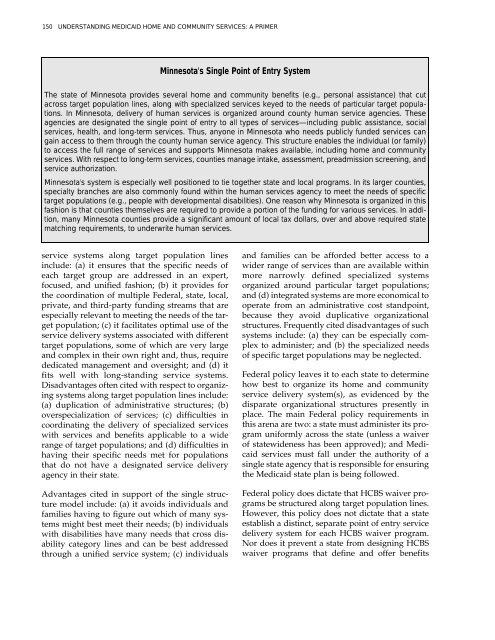Full PDF Version - ASPE - U.S. Department of Health and Human ...
Full PDF Version - ASPE - U.S. Department of Health and Human ...
Full PDF Version - ASPE - U.S. Department of Health and Human ...
- No tags were found...
You also want an ePaper? Increase the reach of your titles
YUMPU automatically turns print PDFs into web optimized ePapers that Google loves.
150 UNDERSTANDING MEDICAID HOME AND COMMUNITY SERVICES: A PRIMERMinnesota's Single Point <strong>of</strong> Entry SystemThe state <strong>of</strong> Minnesota provides several home <strong>and</strong> community benefits (e.g., personal assistance) that cutacross target population lines, along with specialized services keyed to the needs <strong>of</strong> particular target populations.In Minnesota, delivery <strong>of</strong> human services is organized around county human service agencies. Theseagencies are designated the single point <strong>of</strong> entry to all types <strong>of</strong> services—including public assistance, socialservices, health, <strong>and</strong> long-term services. Thus, anyone in Minnesota who needs publicly funded services cangain access to them through the county human service agency. This structure enables the individual (or family)to access the full range <strong>of</strong> services <strong>and</strong> supports Minnesota makes available, including home <strong>and</strong> communityservices. With respect to long-term services, counties manage intake, assessment, preadmission screening, <strong>and</strong>service authorization.Minnesota's system is especially well positioned to tie together state <strong>and</strong> local programs. In its larger counties,specialty branches are also commonly found within the human services agency to meet the needs <strong>of</strong> specifictarget populations (e.g., people with developmental disabilities). One reason why Minnesota is organized in thisfashion is that counties themselves are required to provide a portion <strong>of</strong> the funding for various services. In addition,many Minnesota counties provide a significant amount <strong>of</strong> local tax dollars, over <strong>and</strong> above required statematching requirements, to underwrite human services.service systems along target population linesinclude: (a) it ensures that the specific needs <strong>of</strong>each target group are addressed in an expert,focused, <strong>and</strong> unified fashion; (b) it provides forthe coordination <strong>of</strong> multiple Federal, state, local,private, <strong>and</strong> third-party funding streams that areespecially relevant to meeting the needs <strong>of</strong> the targetpopulation; (c) it facilitates optimal use <strong>of</strong> theservice delivery systems associated with differenttarget populations, some <strong>of</strong> which are very large<strong>and</strong> complex in their own right <strong>and</strong>, thus, requirededicated management <strong>and</strong> oversight; <strong>and</strong> (d) itfits well with long-st<strong>and</strong>ing service systems.Disadvantages <strong>of</strong>ten cited with respect to organizingsystems along target population lines include:(a) duplication <strong>of</strong> administrative structures; (b)overspecialization <strong>of</strong> services; (c) difficulties incoordinating the delivery <strong>of</strong> specialized serviceswith services <strong>and</strong> benefits applicable to a widerange <strong>of</strong> target populations; <strong>and</strong> (d) difficulties inhaving their specific needs met for populationsthat do not have a designated service deliveryagency in their state.Advantages cited in support <strong>of</strong> the single structuremodel include: (a) it avoids individuals <strong>and</strong>families having to figure out which <strong>of</strong> many systemsmight best meet their needs; (b) individualswith disabilities have many needs that cross disabilitycategory lines <strong>and</strong> can be best addressedthrough a unified service system; (c) individuals<strong>and</strong> families can be afforded better access to awider range <strong>of</strong> services than are available withinmore narrowly defined specialized systemsorganized around particular target populations;<strong>and</strong> (d) integrated systems are more economical tooperate from an administrative cost st<strong>and</strong>point,because they avoid duplicative organizationalstructures. Frequently cited disadvantages <strong>of</strong> suchsystems include: (a) they can be especially complexto administer; <strong>and</strong> (b) the specialized needs<strong>of</strong> specific target populations may be neglected.Federal policy leaves it to each state to determinehow best to organize its home <strong>and</strong> communityservice delivery system(s), as evidenced by thedisparate organizational structures presently inplace. The main Federal policy requirements inthis arena are two: a state must administer its programuniformly across the state (unless a waiver<strong>of</strong> statewideness has been approved); <strong>and</strong> Medicaidservices must fall under the authority <strong>of</strong> asingle state agency that is responsible for ensuringthe Medicaid state plan is being followed.Federal policy does dictate that HCBS waiver programsbe structured along target population lines.However, this policy does not dictate that a stateestablish a distinct, separate point <strong>of</strong> entry servicedelivery system for each HCBS waiver program.Nor does it prevent a state from designing HCBSwaiver programs that define <strong>and</strong> <strong>of</strong>fer benefits
















